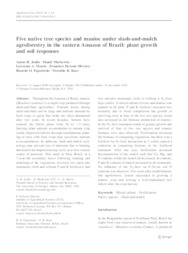Five native tree species and manioc under slash-and-mulch agroforestry in the eastern Amazon of Brazil: plant growth and soil responses.
Five native tree species and manioc under slash-and-mulch agroforestry in the eastern Amazon of Brazil: plant growth and soil responses.
Author(s): JOSLIN, A. H.; MARKEWITZ, D.; MORRIS, L. A.; OLIVEIRA, F. de A.; FIGUEIREDO, R. de O.; KATO, O. R.
Summary: Throughout the Amazon of Brazil, manioc (Manihot esculenta) is a staple crop produced through slash-and-burn agriculture. Nutrient losses during slash-and-burn can be large and nutrient demand by food crops so great that ?elds are often abandoned after two years. In recent decades, farmers have reduced the fallow phase from 20 to *5 years, limiting plant nutrient accumulation to sustain crop yields. Improved fallows through simultaneous planting of trees with food crops may accelerate nutrient re-accumulation. In addition, slash-and-mulch technology may prevent loss of nutrients due to burning and mulch decomposition may serve as a slow-release source of nutrients. This study in Para´, Brazil, in a 7-year-old secondary forest following slashing and mulching of the vegetation, involved two main plot treatments (with and without P and K fertilizers) and two sub-plot treatments (with or without a N2-?xer Inga edulis). A mixed-culture of trees and manioc was planted in all plots. P and K fertilizer increased tree mortality due to weed competition but growth of surviving trees in four of the ?ve tree species tested also increased as did biomass production of manioc. In the N2-?xer treatment trends of greater growth and survival of four of ?ve tree species and manioc biomass were also observed. Fertilization increased the biomass of competing vegetation, but there was a fertilizer by N2 -?xer interaction as I. edulis caused a reduction in competing biomass in the fertilized treatment. After one year, fertilization increased decomposition of the mulch such that Ca, Mg, and N contents within the mulch all decreased. In contrast, P and K contents of mulch increased in all treatments. No in?uence of the N2 -?xer on 0?10 cm soil N contents was observed. Two years after establishment, this agroforestry system succeeded in growing a manioc crop and leaving a well-maintained tree fallow after the crop harvest.
Publication year: 2011
Types of publication: Journal article
Unit: Embrapa Eastern Amazon
Keywords: Mandioca, Manihot esculenta Crantz, Tipitamba
Observation
Some of Embrapa's publications are published as ePub files. To read them, use or download one of the following free software options to your computer or mobile device. Android: Google Play Books; IOS: iBooks; Windows and Linux: Calibre.
Access other publications
Access the Agricultural Research Database (BDPA) to consult Embrapa's full library collection and records.
Visit Embrapa Bookstore to purchase books and other publications sold by Embrapa.

